
A misleading theory about the Five Rites is now circulating on the Internet. According to this theory, the
Five Rites are derived from, or are a form of, Tibetan Yantra Yoga, especially the yoga of Chogyal Namkhai
Norbu. This argument is based on certain supposed similarities between the Five Rites and Yantra Yoga.
The apparent goal of this theory is to "fold" the Five Rites into Tibetan Yantra Yoga, at least in peoples'
minds, then redirect them to Yantra should they want to "learn" more about the Rites.
Something similar has already happened concerning Hatha Yoga. Later Harbor Press editions of the Ancient
Secret of the Fountain of Youth (a pseudonym for the Eye of Revelation) claimed that the Five Rites were
derived from Hatha Yoga, and even went so far as making recommendations for finding Hatha Yoga
instructors. [1] This was a disservice to the students of the Five Rites as the Rites almost certainly predate
Hatha Yoga by hundreds of years . . . if not a thousand or more.
This is not merely an academic issue; rather, it deals directly with the question of where do we go to learn
more about the Five Rites -- which we must do. Consider how effective the Five Rites are compared with
other systems of exercise. I know of no system of exercise that works as well as the Five Rites. No system
of calisthenics. No system of yoga, Tibetan or otherwise. No system of weight training. No system of
aerobics. Nothing.
With just five simple exercises, the Five Rites do the seemingly impossible. They roll back the odometer of
the years. With just five simple exercises, mind you. Name me one system of physical culture that does as
much as the Five Rites, and as quickly and as easily, with just five simple exercises. Name it.
Name one system of exercise that has spawned the incredible comments found about the Rites on Amazon.
com. Name one system of exercise that, by word of mouth alone, came back from near extinction to what is
now a world-wide phenomenon. Name it. [2]
To be sure, Yantra and Hatha Yoga are very beneficial regimens; but they do not, by all accounts, work
anywhere near as well as the Five Rites. They do not inspire the impassioned reviews on Amazon.com you
find for the Five Rites. They do not have just five simple exercises which, practiced alone, produce such
dramatic results.
It is possible, if not downright likely, that the Five Rites are a remnant of a much greater medical technology
from Tibet's forgotten past; perhaps from the Bon tradition which may predate Tibetan Yantra Yoga by
thousands of years. If we incorrectly accept the claim that the Five Rites are derived from, or are a form of,
Tibetan Yantra Yoga, we may never find the true origins of the Rites, origins which might lead us to, not
only to a better understanding of the Rites, but also to additional medical technologies of value equal to or
greater than the Five Rites.
THE COMPARISON CHART
On June 2, 2008, the following chart was first posted on the Internet. It shows images taken from the Eye
of Revelation juxtaposed with images purportedly taken from the works of Chogyal Namkhai Norbu.
(Actually, one of the images is of unknown provenance, and this is an important matter we discuss below.)
Taken at face value, the similarities do seem to be noteworthy; but a closer look reveals otherwise. Here is
a closeup of the comparison for Rite 1:
In the original editions of the Eye of Revelation, Peter Kelder had two sets of circular arrows indicating that
the figure was turning in a clockwise direction. Those arrows were erased to enhance the appearance of
similitude with the image on the Yantra Yoga side. Here is what the original illustration for Rite 1 looks like:
It is clear that the illustration for Rite 1 in the Comparison Chart was deliberately altered to make it look
more like the corresponding illustration on the Yantra side. At this point we need to ask ourselves a simple
question: If the similarities between the Five Rites and Tibetan Yantra Yoga are so telling, why the need to
alter the image for Rite 1? Here's the answer: there is no comparable spinning movement in Tibetan
Yantra Yoga. On this alone we might conclude that the Comparison Chart is less than genuine. There is
more, however.
THE BOGUS PICTURE
There is also a very curious matter about the image used on the Yantra side for Rite 1. It was drawn by a
different artist than was used for the other Tibetan drawings which were taken from the works of Chogyal
Namkhai Norbu (note the lack of facial features when compared to the Yantra illustration for Rite 4):
Just where this "faceless" drawing came from is unknown (the author of this chart declines to comment on
it). It may not even be from a publication about Tibetan Yantra Yoga. So not only was the Eye of
Revelation illustration altered, it was altered to more closely resemble an illustration from an unknown work
to "prove" that Rite 1 came from Tibetan Yantra Yoga of Chogyal Namkhai Norbu. And here we must ask
ourselves, if the similarities between the Five Rites and Tibetan Yantra Yoga are so compelling, why the need
for deception?
DATA MINING
I think most people looking only at the Comparison Chart would conclude that there was an 80 - 90%
correlation between the Rites and Yantra. Compelling, it would seem; but, very deceptive.
By my count there are 826 separate line drawings in Nauru's Yantra Yoga. Only nine bear a resemblance to
illustrations for the Five Rites. This means that in a full comparison of the Five Rites and Tibetan Yantra
Yoga we can conclude with about 98.9% certainty that the Rites are NOT similar to Tibetan Yantra Yoga.
And what few correspondences there are can probably be written off to chance. After all, with 826 drawings
to choose from, you'd be bound to find a few that resemble something from the Five Rites.
The Comparison Chart in question is a stunning example of data mining, the practice of presenting or using
only information that supports one's preconceived notions or theories. Most of the images in the
Comparison Chart were taken out of context. Only one or two positions were selected out of a series of
six, seven or eight positions in Tibetan Yantra Yoga. Using this data mining technique, you could probably
"prove" that Tibetan Yantra Yoga is the ancestor of modern gymnastics or even some martial arts, such as
Tai Chi Chuan. And maybe a whole host of other things, as well. As Dorothy Sayers wrote, you can prove
almost anything if only you sufficiently limit your point of view.
Below we show the full extent of the data mining by placing the Yantra images in their full context. Please
remember that while some similarities may seem to exist, they are probably due to chance. For every set of
postures shown below on the Yantra side, there are dozens more showing no similarity at all.
Rite 1:
Rite 2:
Rite 3:
Rite 4:
Rite 5:
As you can see, the actual sequence of moves from which the comparison figures were taken do not
resemble the Five Rites in a way which would lead a person of average intelligence to conclude that the Five
Rites are directly related to Tibetan Yantra Yoga . . . especially when you consider that 98.9% of the 826
images are dissimilar!
If there was really any solid evidence for the claim that the Five Rites descended from, or are a form of,
Tibetan Yantra Yoga, there would be no need to doctor illustrations, or bring in an illustration from God
knows where, just to make it appear that there is a spinning motion in Yantra when there is not. Nor would
there be a need for data mining. Data mining can happen innocently enough when born of enthusiasm for a
particular theory; but when it is done this blatantly and boldly it makes one wonder about the motives of
the chart's creator.
-
Note: The Tibetan Yantra Yoga images are fromYantra Yogaby Chögyal Namkhai Norbu. It is considered the most
thorough treatment of Tibetan Yantra ever published in Englishand we would be remiss should we not use it.
Norbu used the same artist in his earlier works as he did inYantra Yoga, sothe images are identical -- just more
complete.
TheComparisonChart was published a few months beforethe publication ofYantra Yoga. Earlier works by Norbu
apparently did nothavethe "spread eagle" pose, which was a serious problem for the chart's creatorwho then
had to "go fish" for asubstitute.
ButYantra Yogadoes contain some figures that are much more similar to the illustration for Rite 1. Had the
ComparisonChart been producedafterthe publication ofYantra Yoga, no doubtall the imageswould have been
taken from it and thechart's creator would not have needed the bogus image.
We use images fromNauru'sYantra Yogabecause it is the most comprehensive work with which we can compare
the FiveRites. And we use it to help confirm that a bogus image was, in fact, used.
THE COVER-UP
Internet without explanation (or apology), but the argument did not go away. Today another Comparison
Chart has been published by the same person or persons who gave us the first one. This time only the last
three Rites are included (apparently conceding the point that the comparisons for Rites 1 & 2 don't hold
up). There is just as much data mining for the remaining three Rites, however.
The main thrust of this new chart is a carefully worded, totally undocumented set of statements crafted to
create the illusion of similitude between the Rites and Yantra. It does with words what the Comparison
Chart did with images, which is to say that it is filled with nonsense. Given the history of the first chart, I
know of no rational way to accept anything in the second, unless it gets peer reviewed. And that I would
love to see.
________________
[1] Peter Kelder, Ancient Secret of the Fountain of Youth: Book 2; Doubleday (New York), 1999, p. 285.
[2] Kum Nye, an ancient system of exercise from the Bon tradition of Tibet, certainly comes close,
however. In my articles about the origins of the Five Rites, I mention Kum Nye as a possible progenitor of
the Five Rites.
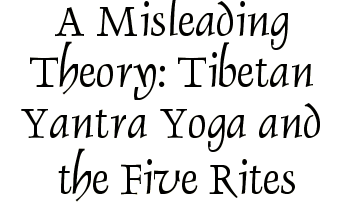 |


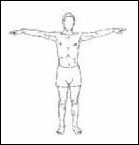

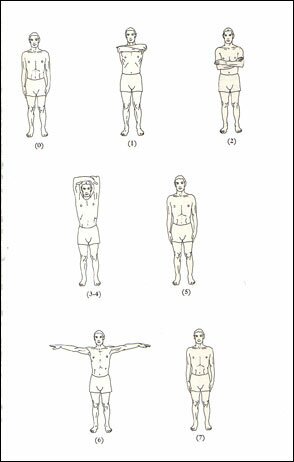
Chogyal Namkhai Norbu, Yantra Yoga, Snow
Lion, p 175. Bruno Irmici, illustrator.
Lion, p 175. Bruno Irmici, illustrator.
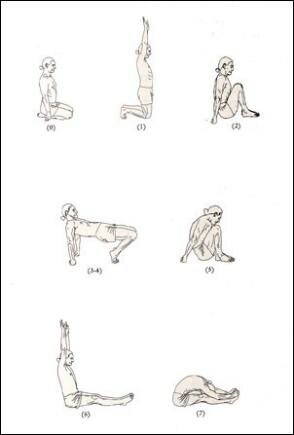
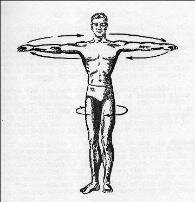
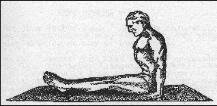


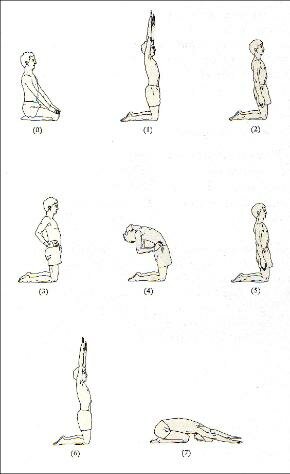
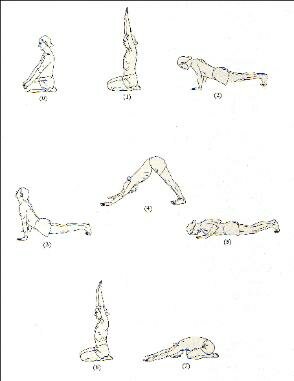

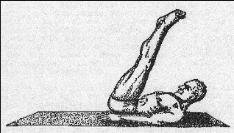
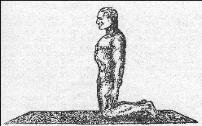



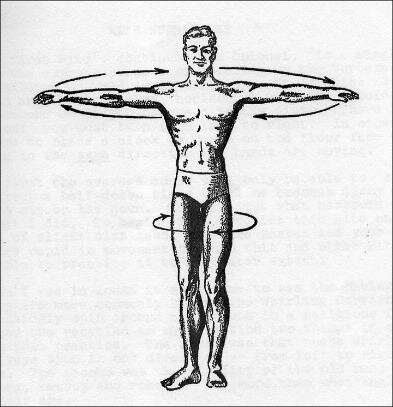
Chogyal Namkhai Norbu, Yantra Yoga, Snow
Lion, p 71. Bruno Irmici, illustrator.
Lion, p 71. Bruno Irmici, illustrator.
Chogyal Namkhai Norbu, Yantra Yoga, Snow
Lion, p 63. Bruno Irmici, illustrator.
Lion, p 63. Bruno Irmici, illustrator.
Chogyal Namkhai Norbu, Yantra Yoga, Snow
Lion, p 75. Bruno Irmici, illustrator.
Lion, p 75. Bruno Irmici, illustrator.
Chogyal Namkhai Norbu, Yantra Yoga, Snow
Lion, p 105. Bruno Irmici, illustrator.
Lion, p 105. Bruno Irmici, illustrator.
Peter Kelder, The Eye of
Revelation, 1939, p. 8.
Revelation, 1939, p. 8.
Peter Kelder, The Eye of Revelation,
1939, p. 10.
1939, p. 10.
Peter Kelder, The Eye of
Revelation, 1939, p. 12.
Revelation, 1939, p. 12.
Peter Kelder, The Eye of
Revelation, 1939, p. 14.
Revelation, 1939, p. 14.
Peter Kelder, The Eye of
Revelation, 1939, p. 16.
Revelation, 1939, p. 16.

| May 23, 2010 - Age 66 |
This work is the intellectual property of its author and is fully
copyrighted. It may not be copied or republished in any medium
(including but not limited to electronic and print media) without the
express permission of the author. All rights are reserved.
copyrighted. It may not be copied or republished in any medium
(including but not limited to electronic and print media) without the
express permission of the author. All rights are reserved.